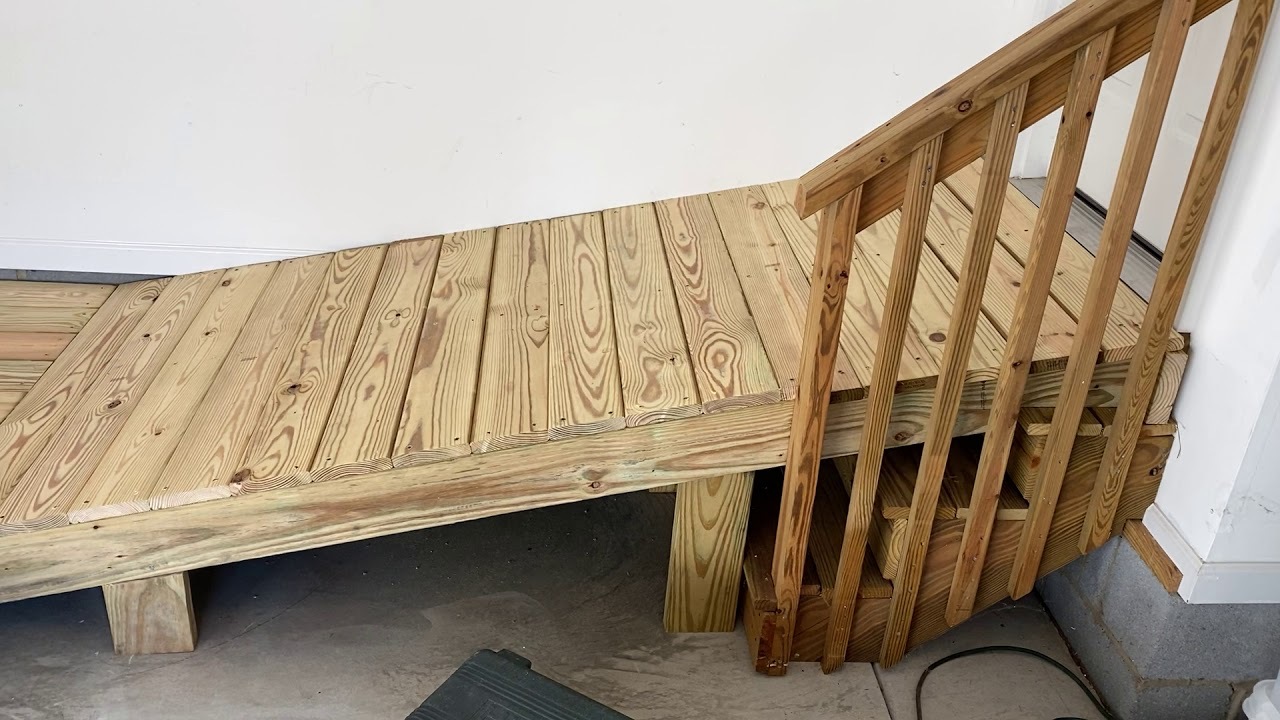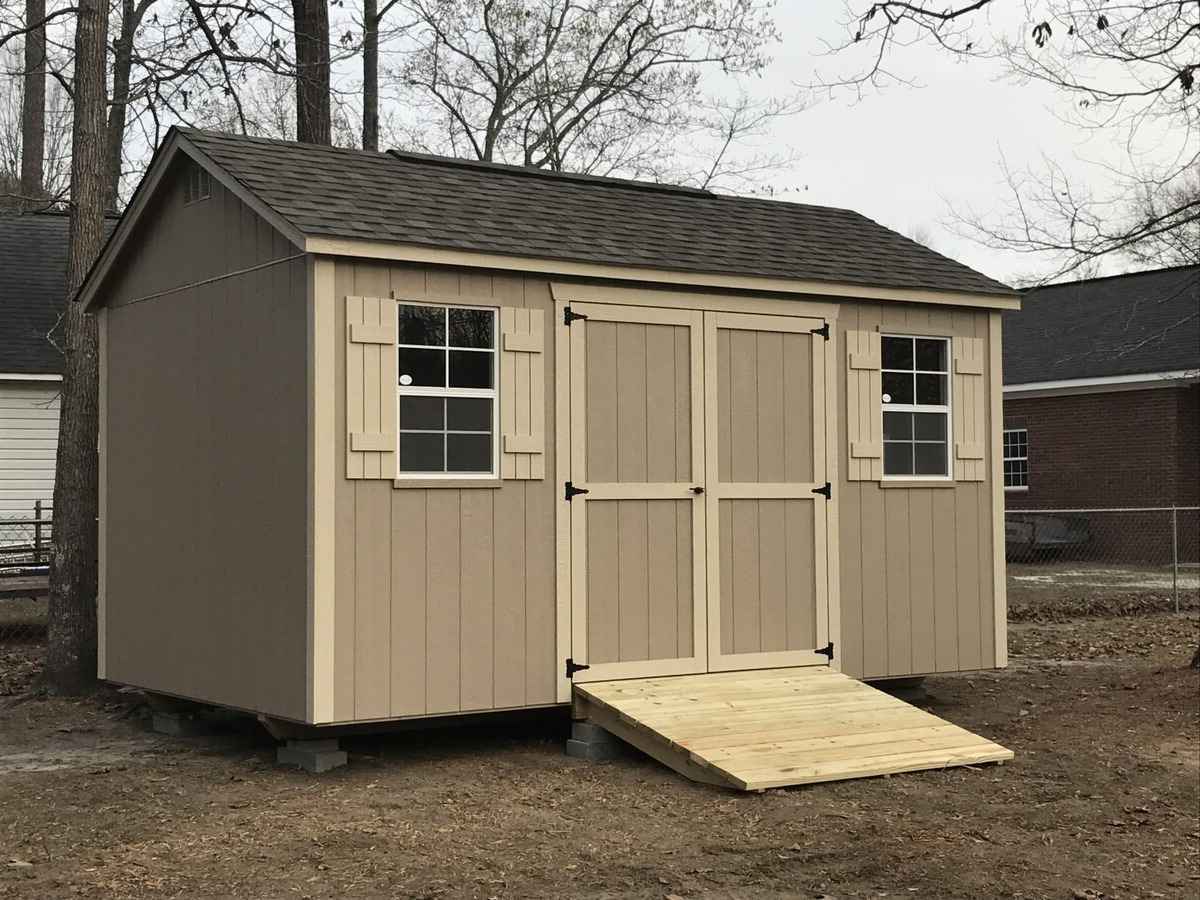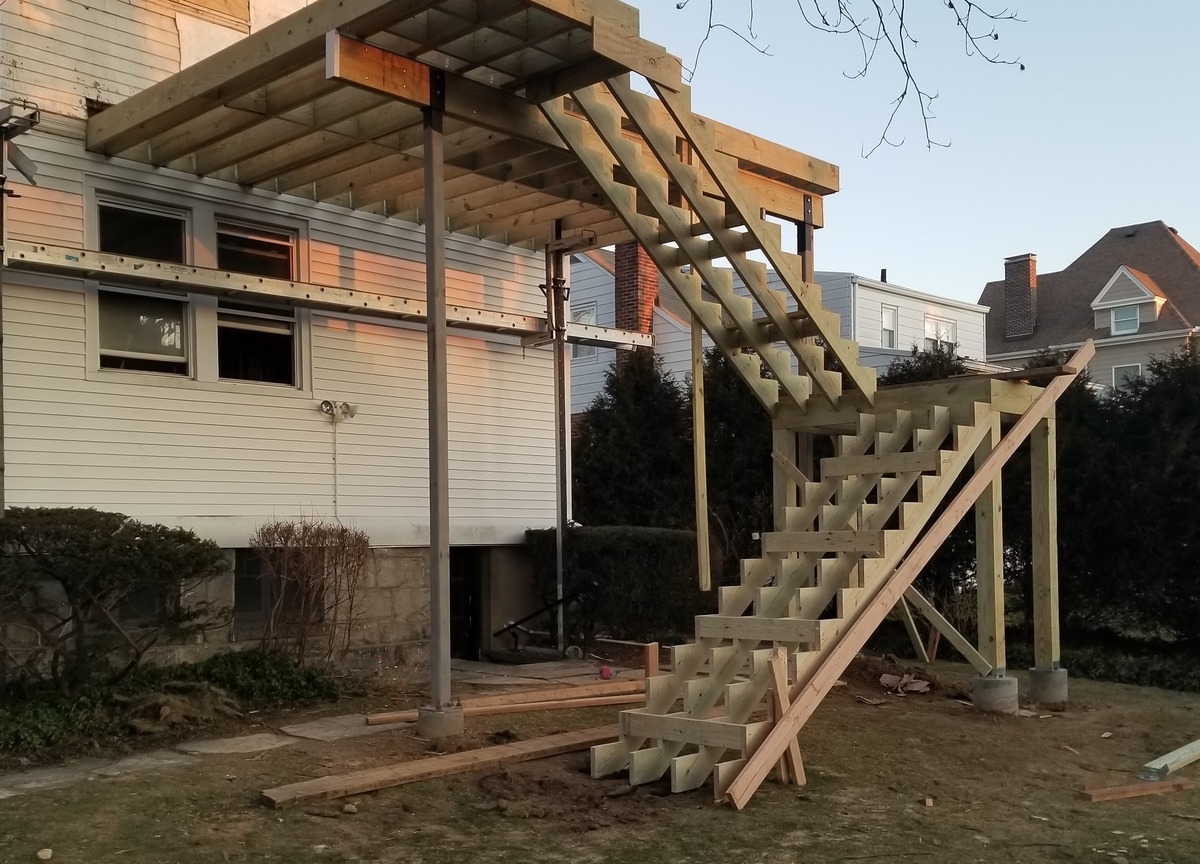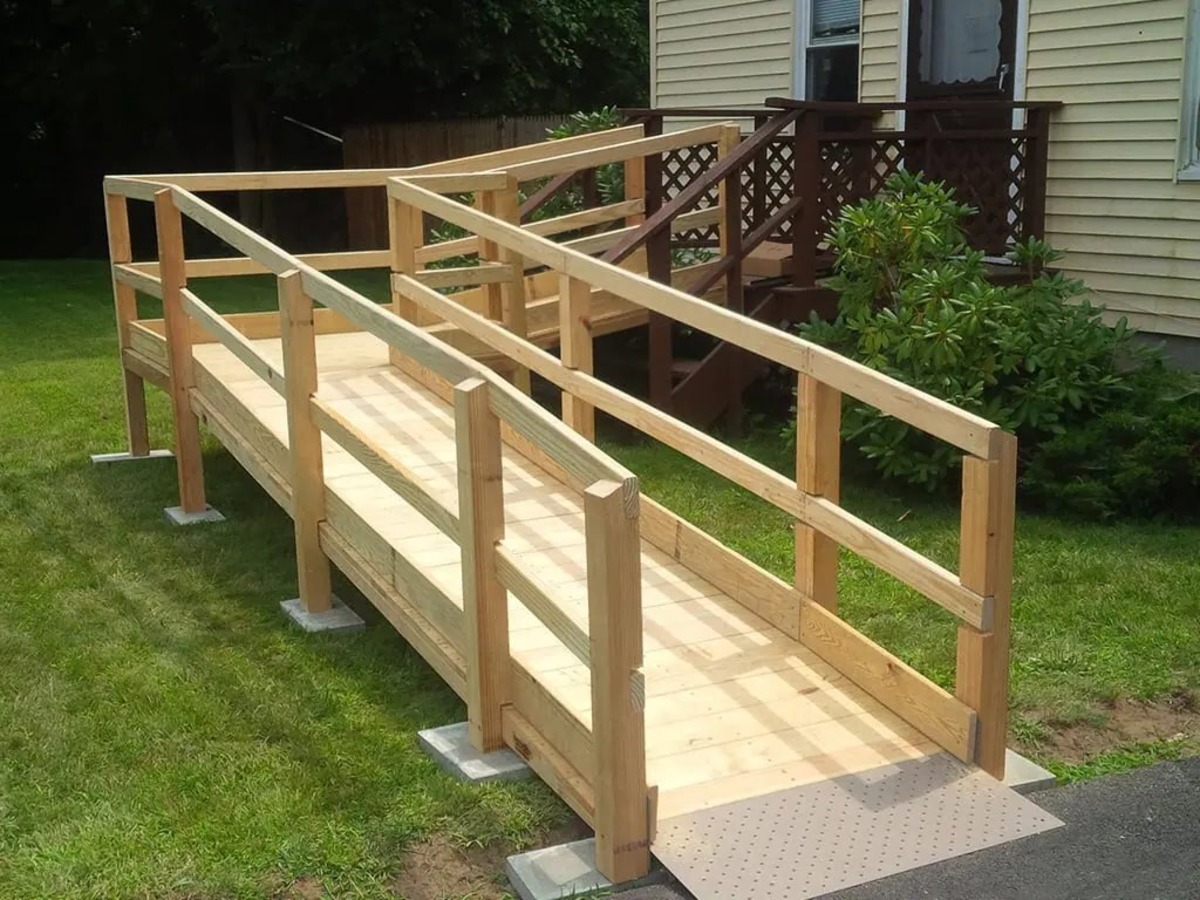Home>Create & Decorate>DIY & Crafts>How To Build A Ramp Over Stairs


DIY & Crafts
How To Build A Ramp Over Stairs
Published: February 28, 2024

Senior Editor in Create & Decorate, Kathryn combines traditional craftsmanship with contemporary trends. Her background in textile design and commitment to sustainable crafts inspire both content and community.
Learn how to build a DIY ramp over stairs with our step-by-step guide. Perfect for easy access and mobility. Get started with our DIY & Crafts tutorial!
(Many of the links in this article redirect to a specific reviewed product. Your purchase of these products through affiliate links helps to generate commission for Twigandthistle.com, at no extra cost. Learn more)
Introduction
Building a ramp over stairs can be a practical and empowering DIY project, providing accessibility and convenience for individuals with mobility challenges or those who require assistance navigating steps. Whether it's for a home, office, or public space, a well-constructed ramp can make a significant difference in improving accessibility and inclusivity.
In this comprehensive guide, we will walk you through the step-by-step process of building a sturdy and safe ramp over stairs. From assessing the area and gathering materials to measuring, planning, and adding essential safety features, this guide will equip you with the knowledge and confidence to undertake this project with ease.
By following these instructions, you can create a functional and aesthetically pleasing ramp that seamlessly integrates with the existing architecture while prioritizing safety and durability. Whether you're a seasoned DIY enthusiast or a novice looking to expand your skills, this guide will provide valuable insights and practical tips to help you successfully complete this project.
So, roll up your sleeves, gather your tools, and let's embark on this rewarding journey of creating a ramp that not only serves a practical purpose but also enhances the accessibility and usability of the space. Let's get started!
Read more: DIY Dog Ramp For Stairs: Step-by-Step Guide
Step 1: Assessing the Area
Before diving into the construction of a ramp over stairs, it is crucial to thoroughly assess the area where the ramp will be installed. This initial step sets the foundation for a successful and well-executed project. Here's a detailed breakdown of the key aspects to consider during the assessment phase:
1.1 Understanding Local Building Codes and Regulations
Begin by researching and familiarizing yourself with the local building codes and regulations pertaining to ramps and accessibility modifications. These codes often dictate specific requirements for ramp incline, width, railing height, and landing dimensions. Adhering to these regulations is essential to ensure the ramp meets safety standards and legal requirements.
1.2 Evaluating the Existing Staircase
Carefully examine the structure and dimensions of the existing staircase. Take precise measurements of the width, height, and depth of each step. Additionally, assess the surrounding space to determine the most suitable location for the ramp. Consider factors such as foot traffic flow, proximity to entry points, and any potential obstructions that may impact the ramp's design and functionality.
1.3 Analyzing the Terrain and Environmental Factors
Take into account the terrain and environmental conditions surrounding the installation area. If the ramp will be exposed to outdoor elements, such as rain, snow, or direct sunlight, it's important to select materials that can withstand these conditions without compromising safety or durability. Additionally, assess the ground surface for any irregularities or slopes that may require adjustments to ensure a level and stable foundation for the ramp.
Read more: How To Build Deck Stairs
1.4 Identifying User Needs and Accessibility Requirements
Consider the specific needs of the individuals who will be using the ramp. Take into account mobility aids such as wheelchairs, walkers, or mobility scooters, and ensure that the ramp's design accommodates smooth and safe passage for users of varying mobility levels. Understanding these requirements is essential for creating a ramp that prioritizes accessibility and user comfort.
1.5 Budget and Resource Assessment
Evaluate the budget and resources available for the project. Consider the cost of materials, tools, and any professional assistance that may be required. By assessing the budget upfront, you can make informed decisions when selecting materials and planning the construction process, ensuring that the project remains within the allocated budget.
By meticulously assessing these key factors, you will lay the groundwork for a well-informed and strategic approach to building a ramp over stairs. This thorough evaluation sets the stage for the subsequent steps, guiding the decision-making process and ensuring that the ramp is tailored to the specific needs of the space and its users.
Step 2: Gathering Materials and Tools
Gathering the necessary materials and tools is a critical precursor to the construction phase of building a ramp over stairs. By ensuring that you have all the essential components and equipment at your disposal, you can streamline the construction process and minimize potential delays. Here's a comprehensive list of materials and tools required for this project:
Materials:
-
Pressure-Treated Lumber: Select high-quality pressure-treated lumber that is resistant to rot and decay, ensuring the longevity of the ramp structure. The lumber will be used for constructing the frame, decking, and support posts.
-
Plywood or Composite Decking: Choose plywood or composite decking material to create a smooth and durable surface for the ramp. Consider the material's resistance to weathering and its ability to provide a secure footing for users.
-
Galvanized Screws and Nails: Opt for corrosion-resistant screws and nails to secure the structural components of the ramp. These fasteners should be suitable for outdoor use and capable of withstanding varying weather conditions.
-
Concrete Footings: If the ramp requires support posts or footings, procure concrete and the necessary forms to create stable and secure foundations for the ramp's structural elements.
-
Ramp Surfacing Material: Depending on the specific requirements and user needs, consider additional surfacing materials such as non-slip treads or rubber matting to enhance traction and safety.
-
Handrail Components: If handrails are part of the design, gather the necessary components, including handrail posts, balusters, and handrail sections, ensuring compliance with local building codes and accessibility standards.
-
Weatherproof Sealant or Paint: Select a weatherproof sealant or paint to protect the ramp's surface and structural elements from moisture, UV exposure, and general wear and tear.
Read more: How To Build A Ramp
Tools:
-
Measuring Tape and Level: Accurate measurements and precise leveling are crucial for ensuring the structural integrity and safety of the ramp. A reliable measuring tape and level are indispensable tools throughout the construction process.
-
Circular Saw or Miter Saw: A high-quality circular saw or miter saw is essential for cutting lumber and decking materials to the required dimensions with precision and efficiency.
-
Drill and Impact Driver: A drill and impact driver, equipped with appropriate drill bits and screwdriver attachments, are essential for fastening components and creating pilot holes for screws and fasteners.
-
Shovel and Wheelbarrow: If the project involves excavation or concrete work, a sturdy shovel and wheelbarrow will be necessary for transporting and handling materials such as gravel, concrete, and soil.
-
Safety Gear: Prioritize safety by ensuring you have appropriate personal protective equipment, including gloves, safety goggles, and dust masks, to safeguard against potential hazards during construction.
By procuring these materials and tools, you will be well-prepared to embark on the construction phase of building a ramp over stairs. This comprehensive inventory equips you with the essentials needed to execute the project efficiently and with a focus on quality and safety.
Step 3: Measuring and Planning
Accurate measurements and meticulous planning are fundamental to the successful construction of a ramp over stairs. This crucial step lays the groundwork for ensuring that the ramp is tailored to the specific dimensions of the installation area and aligns with the accessibility needs of its users.
3.1 Taking Precise Measurements
Begin by using a measuring tape to record the exact dimensions of the designated installation area. Measure the width and length of the space where the ramp will be positioned, taking into account any architectural features or obstructions that may impact the ramp's design. Additionally, measure the height and depth of each step of the existing staircase to determine the optimal slope and length of the ramp. Accurate measurements are essential for creating a ramp that seamlessly integrates with the surrounding environment and provides safe and convenient access.
3.2 Determining Ramp Incline and Length
Based on the measured dimensions, calculate the required incline and length of the ramp to ensure compliance with accessibility standards and safety guidelines. The incline, often expressed as a ratio of rise over run, determines the slope of the ramp and its ease of use for individuals with mobility aids. Additionally, consider the available space and the desired landing area at the top and bottom of the ramp to facilitate smooth transitions for users. By carefully determining the ramp's incline and length, you can optimize its functionality and user-friendliness.
Read more: How To Build Stairs
3.3 Creating Detailed Plans and Blueprints
Translate the measurements and incline calculations into detailed plans and blueprints for the ramp's construction. Sketch out the design, indicating the dimensions of the frame, support posts, decking, and any additional features such as handrails or safety barriers. Consider the materials to be used and their specific placement within the design. These detailed plans serve as a visual guide and reference during the construction phase, ensuring that the project progresses smoothly and according to the predetermined specifications.
3.4 Addressing Safety and Compliance
During the planning phase, prioritize safety and compliance with building codes and accessibility standards. Ensure that the planned ramp design adheres to the required width, railing height, and landing dimensions specified by local regulations. Additionally, consider incorporating non-slip surfacing materials and appropriate handrail configurations to enhance user safety and accessibility. By integrating these safety measures into the planning process, you can proactively address potential hazards and ensure that the ramp meets established safety standards.
By meticulously measuring the installation area, calculating the ramp's incline and length, creating detailed plans, and prioritizing safety considerations, you set the stage for a well-executed construction phase. This thorough planning process forms the blueprint for constructing a ramp that not only meets functional requirements but also prioritizes safety and accessibility for all users.
Step 4: Building the Frame
Building the frame serves as the foundational element of the ramp's structure, providing stability and support for the entire installation. The frame construction phase involves assembling the primary framework onto which the ramp's decking and surfacing materials will be secured. Here's a comprehensive breakdown of the essential steps involved in building the frame for the ramp over stairs:
4.1 Selecting and Preparing the Lumber
Begin by selecting high-quality pressure-treated lumber that is suitable for outdoor use and capable of withstanding varying weather conditions. The lumber should be resistant to rot, decay, and insect damage, ensuring the long-term durability of the ramp's frame. Once the lumber is acquired, carefully measure and cut the individual components, including the joists, headers, and support posts, to the precise dimensions specified in the construction plans.
Read more: How To Build Outdoor Stairs
4.2 Assembling the Joists and Headers
Lay out the cut lumber according to the predetermined plans, ensuring that the joists are spaced evenly to provide adequate support for the ramp's decking and surfacing materials. Secure the joists to the headers using corrosion-resistant screws or nails, creating a sturdy and level framework that forms the basis of the ramp's structure. Pay close attention to the alignment and spacing of the joists to maintain uniformity and structural integrity.
4.3 Installing Support Posts and Footings
If the ramp design necessitates support posts and footings, proceed to install these components at strategic intervals along the frame. Dig the necessary holes for the footings, ensuring that they are deep enough to provide stable support for the posts. Pour concrete into the holes and set the support posts securely in place, aligning them according to the predetermined layout. Once the concrete has cured, verify that the support posts are level and securely anchored to the footings.
4.4 Securing the Frame to the Existing Structure
If the ramp is attached to an existing building or structure, carefully secure the frame to the designated anchor points using appropriate fasteners and hardware. Ensure that the attachment is robust and capable of withstanding the anticipated load and usage of the ramp. By securely fastening the frame to the existing structure, you establish a seamless and integrated connection that enhances the overall stability and safety of the ramp.
4.5 Verifying Structural Integrity and Alignment
Upon completing the frame assembly, meticulously inspect the entire structure to verify its structural integrity and alignment. Use a level to ensure that the frame is perfectly horizontal and free from any unevenness or deviations. Additionally, confirm that all connections and joints are secure and that the frame is capable of supporting the anticipated weight and usage. Address any discrepancies or issues promptly to maintain the structural soundness of the frame.
By meticulously following these steps, you will successfully construct a robust and reliable frame for the ramp over stairs, laying the groundwork for the subsequent phases of the construction process. The completed frame forms the structural backbone of the ramp, providing a solid foundation for the installation of decking, surfacing materials, and additional safety features.
Read more: How To Build A Wheelchair Ramp
Step 5: Installing the Ramp Surface
With the frame securely in place, the next pivotal phase of constructing a ramp over stairs involves the installation of the ramp surface. This critical step transforms the structural framework into a functional and accessible pathway, providing a smooth and secure transition for users. Here's a detailed breakdown of the essential tasks involved in installing the ramp surface:
5.1 Selecting and Preparing the Decking Material
Carefully select the appropriate decking material, considering factors such as durability, weather resistance, and traction. Whether opting for plywood or composite decking, ensure that the chosen material aligns with the project's requirements and user needs. Prepare the decking material by cutting it to the precise dimensions specified in the construction plans, allowing for a seamless fit within the frame.
5.2 Securing the Decking to the Frame
Position the prepared decking material onto the frame, ensuring that it aligns evenly and overlaps the frame's edges as intended. Secure the decking to the frame using corrosion-resistant screws or nails, fastening it securely to provide a stable and level surface. Pay close attention to the spacing and placement of fasteners to maintain uniformity and structural integrity across the entire ramp surface.
5.3 Adding Non-Slip Features
Prioritize user safety by incorporating non-slip features into the ramp surface. Consider applying non-slip treads, adhesive strips, or rubber matting to enhance traction and minimize the risk of slips or falls, particularly in outdoor or high-traffic environments. These non-slip elements contribute to the overall safety and usability of the ramp, catering to the diverse mobility needs of its users.
Read more: How To Build A Loft Bed With Stairs
5.4 Applying Weatherproof Sealant or Paint
Protect the ramp surface from environmental elements and wear by applying a weatherproof sealant or paint. Select a high-quality sealant or paint designed for outdoor use, capable of safeguarding the decking material from moisture, UV exposure, and general wear and tear. The application of a weatherproof coating enhances the longevity and visual appeal of the ramp surface, ensuring its resilience in varying weather conditions.
5.5 Verifying Surface Integrity and Functionality
Upon completing the installation of the ramp surface, conduct a thorough inspection to verify its integrity and functionality. Ensure that the surface is level, free from protrusions or irregularities, and capable of supporting the anticipated user load. Test the non-slip features to confirm their effectiveness and make any necessary adjustments to optimize the surface's safety and usability.
By meticulously following these steps, you will successfully install a durable and user-friendly ramp surface, transforming the frame into a fully functional and accessible pathway. The completed ramp surface not only enhances the overall aesthetics of the installation but also prioritizes safety and convenience for all users, reflecting the meticulous attention to detail and quality craftsmanship invested in the project.
Step 6: Adding Handrails and Safety Features
The integration of handrails and additional safety features represents a pivotal phase in the construction of a ramp over stairs, emphasizing the paramount importance of user safety and accessibility. This step focuses on enhancing the functionality and security of the ramp, catering to the diverse mobility needs of its users while adhering to established safety standards. Here's a comprehensive overview of the essential tasks involved in adding handrails and safety features to the ramp:
6.1 Selecting Handrail Components
Begin by selecting the necessary handrail components, including handrail posts, balusters, and handrail sections, in accordance with local building codes and accessibility regulations. Prioritize the use of durable and weather-resistant materials that can withstand outdoor conditions while providing reliable support for users navigating the ramp.
Read more: How To Build Stair Stringers
6.2 Installing Handrail Posts
Position the handrail posts at strategic intervals along the ramp, ensuring that they are securely anchored to the frame and capable of withstanding the anticipated load. Align the posts according to the predetermined layout, maintaining uniform spacing and ensuring their vertical alignment to facilitate the installation of handrail sections.
6.3 Attaching Handrail Sections and Balusters
Secure the handrail sections and balusters to the installed posts, creating a continuous and sturdy handrail system that runs along the length of the ramp. Pay close attention to the secure attachment of handrail components, verifying their stability and compliance with specified height requirements to ensure user safety and support.
6.4 Incorporating Safety Barriers and Edging
Consider the inclusion of safety barriers and edging features, particularly in elevated or exposed areas of the ramp, to prevent accidental falls and provide additional security for users. Install robust barriers and edging materials that blend seamlessly with the ramp's design while effectively delineating safe pathways and potential hazards.
6.5 Verifying Compliance and Functionality
Conduct a comprehensive assessment to verify the compliance of the installed handrails and safety features with local regulations and accessibility standards. Test the functionality of the handrail system, ensuring that it provides reliable support and guidance for users of varying mobility levels. Address any discrepancies or adjustments to optimize the safety and usability of the ramp.
By meticulously following these steps, you will successfully integrate robust handrails and safety features into the ramp over stairs, underscoring the project's commitment to prioritizing user safety and accessibility. The completed installation not only enhances the overall security and usability of the ramp but also reflects a conscientious approach to creating an inclusive and welcoming environment for all individuals.
Read more: How To Build A Handicap Ramp
Conclusion
In conclusion, the construction of a ramp over stairs represents a transformative endeavor that goes beyond the realm of a typical do-it-yourself project. It embodies a profound commitment to inclusivity, accessibility, and the creation of spaces that prioritize the diverse needs of individuals with mobility challenges. Throughout the comprehensive process of building a ramp, from the initial assessment to the integration of safety features, the underlying ethos revolves around empowering individuals to navigate their surroundings with dignity, independence, and safety.
As the final pieces of the ramp come together, the culmination of meticulous planning, precise measurements, and skilled craftsmanship results in more than just a functional structure. It represents a tangible embodiment of compassion, consideration, and a deep understanding of the impact that thoughtful design and construction can have on the lives of others.
The completion of a well-constructed ramp over stairs signifies a tangible shift towards a more inclusive and accessible environment, whether it's within a residential setting, a public space, or a commercial establishment. It serves as a testament to the unwavering commitment to breaking down barriers and creating pathways that transcend physical limitations, fostering a sense of belonging and equal access for all.
Moreover, the journey of building a ramp over stairs is not merely a technical feat; it is a testament to the power of empathy and the recognition of the inherent value of every individual's ability to navigate and engage with their surroundings. It embodies the spirit of community, empathy, and the unwavering belief in the importance of creating spaces that welcome and accommodate everyone, regardless of their mobility capabilities.
As the final touches are put in place, the completed ramp stands as a symbol of inclusivity, a physical embodiment of the values of empathy and accessibility. It serves as a reminder that every step taken to create a more inclusive environment is a step towards a more compassionate and equitable world for all.








